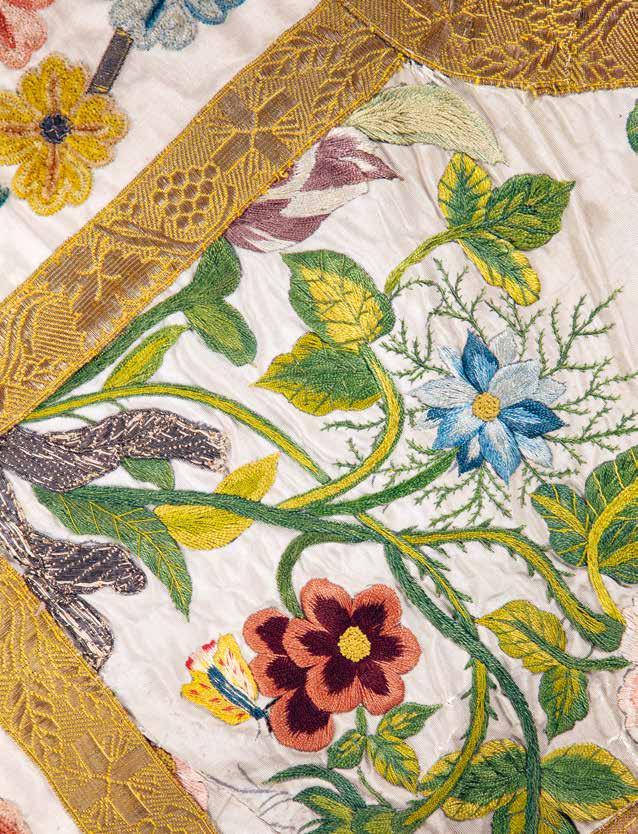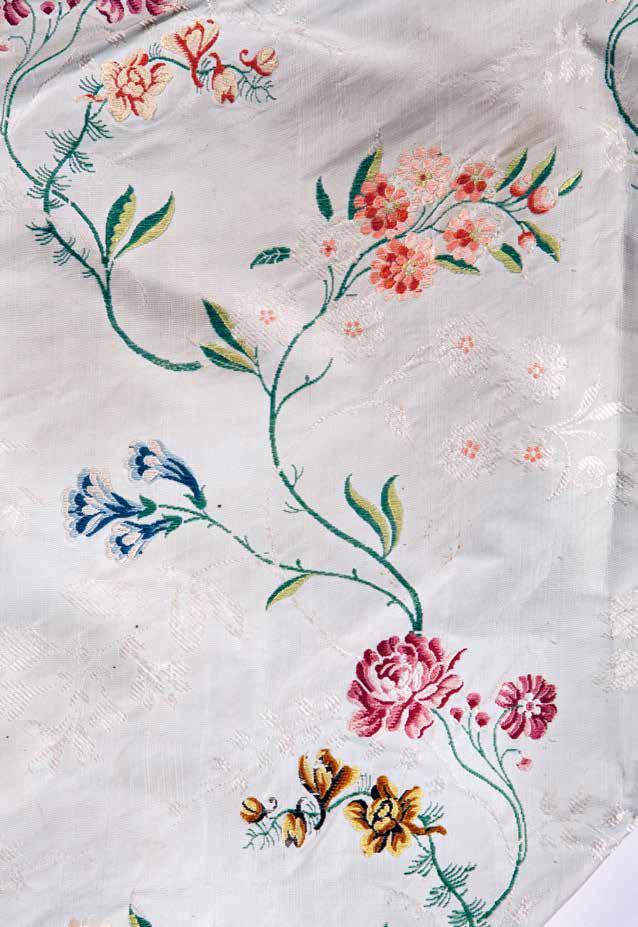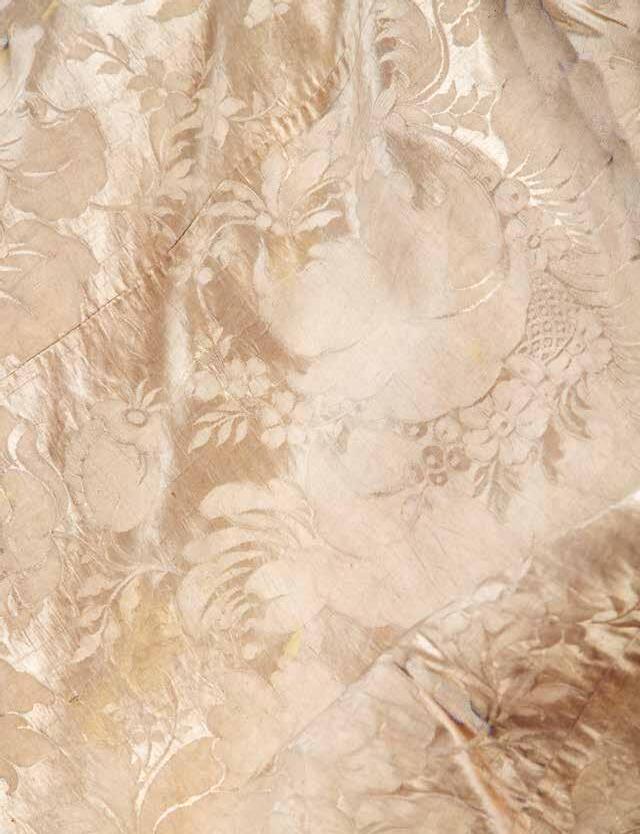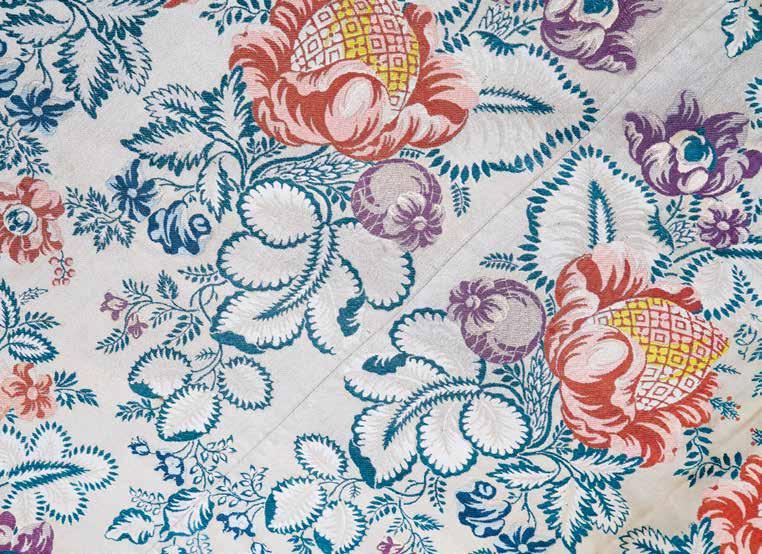


















Foreword 12
Marieke van Schijndel
Introduction 13-14 Richard de Beer en Pim Arts
Essays 16-24 Dirk Jan Schoon
The Church of Utrecht and the Dutch Mission: Synonyms and Schism
25-37 Richard de Beer
Women at Work
Catholic Church Vestments in the Northern Netherlands 1580-1700
38-43 Marike van Roon
The Opulence of Gold, Silver and Silk
Embroidery in fashion 1580-1650
44-53 René Lugtigheid
Eighteenth-century Vestments with ‘Coloured’ Flowers
54-63 Pim Arts
Silk: Trade and Production in the
Catalogue
82-151 Seventeenth century
152-214 Eighteenth century
With contributions from: Pim Arts
Richard de Beer
Ria Cooreman
Madelief Hohé
René Lugtigheid
Susan North Marike van Roon
Fashion for God is the intriguing title of an exhibition about Catholic church vestments in the period of the clandestine churches in the Netherlands, at Museum Catharijneconvent from 13 October 2023 to 21 January 2024. An intriguing title for an extraordinary exhibition. Fashion is often temporary, transient, whereas church vestments seem to represent the importance of the eternal. The title does not refer to merely any old fashion, however, but fashion for God. Fashion made to honour God. Fashion for God tells the story of an art form that is the quintessential expression of identity. This publication is about the artistic splendour of precious ecclesiastical textile, about the identity of the Catholic church in times of oppression, and about those who made, wore and donated these garments.
We are grateful to the Old Catholic Church of the Netherlands for its generous loans of its textile heritage. Thanks also to the funds that sponsored the publication, and in particular to Frank Vroom, whose Frank N. Vroom Fund paid for the restoration of some important pieces. The academic research on the ecclesiastical textiles collection was awarded a museum grant by the Dutch Research Council, and was partially funded by Ms De Boeck-Rinkel’s bequest for the preservation of Old Catholic heritage. I would particularly like to thank Dr. Richard de Beer and Pim Arts for compiling this catalogue, all the other authors who wrote a contribution, and expert advisors Professor Peter-Ben Smit, Dr. Dick Schoon, Dr. Marike van Roon and Dr. René Lugtigheid for their invaluable advice.
The story behind Fashion for God and this publication is a long one. It begins with the previous exhibition on ecclesiastical textiles in 2015. Soon after the success of The Secret of the Middle Ages in Gold Thread and Silk, it became clear that a follow-up exhibition would be needed, focusing on post-Reformation ecclesiastical textiles: a part of the richly varied, unparalleled and fragile collection of Museum Catharijneconvent that is well worth exploring and studying in detail.
Various churches in the Netherlands also house a treasure trove of ecclesiastical textiles from the period up to 1800, many of these priceless items still kept in the place for which they were made. Interestingly, they tend to be Old Catholic churches. The Old Catholic Church and the Old Catholic Museum, one of the forerunners of Museum Catharijneconvent, are an invaluable source, for which the curators of this exhibition are very thankful.
2023 and 2024 are memorable years for the Old Catholic Church, as it commemorates the election of Cornelis Steenoven as Bishop of the Netherlands in 1723 and his consecration in 1724. This cemented the schism between the Roman Catholic Church and the Old Catholic Church in the Netherlands. Fashion for God shows in unexpected ways how this part of church history can be told through ecclesiastical textiles.
This important publication and the exhibition it accompanies would not have been possible without the vital input and support of many parties.
Since time immemorial, textiles have played a prominent role in religious ceremonies in many cultures and religions. Priests have worn special vestments and cloths have been used to conceal certain items and enhance the mystery of the occasion. In some cases, the design and use of religious textiles has remained the same for centuries, but others have changed along with the associated traditions. The purpose of the textiles was generally to underline the exalted nature of the ceremony, the mystique of the ritual or the status of a priest.
Paramentics dictates the use of textiles in the Catholic church. In the broad sense, paraments are all textile items and vestments that a priest wears or uses at or on the altar during mass and other religious services. The paraments are part of a larger whole, known as the liturgy. Along with other prescribed objects, such as the silver on the altar, and objects that are less subject to certain rules, like painted or sculpted altarpieces, they enhance both the lofty character of the ritual and the viewer’s experience. But less tangible elements such as light, sound and fragrances also play a role in defining rituals.
The paraments that priests still wear during mass originated in garments worn in late antiquity: the priest’s chasuble, the assistant priests’ tunicle and dalmatic, and the cope that a priest would wear during a service without the eucharist. These vestments changed little during the course of the Middle Ages; only the chasuble became slightly narrower. Their shape, colour and decoration were not dictated or regulated at that time, except in the form of centuries of custom and tradition. The more luxurious the material or decoration, the more suitable it was for the special celebrations held during the ecclesiastical year. Many medieval vestments were made of silk and had decorative embroidery in silk, gold and silver thread, often depicting saints or scenes from the Bible. Since the priest stood with his back to the congregation throughout much of the mass, it was on the back of the chasuble that the most decorative elements would be.
It was not until the Council of Trent (1545-1563) and the subsequent Roman
Missal of 1570 that centralised orders were issued regarding paraments, under the influence of the CounterReformation. The missal, which for many years defined the standard in the Catholic church, introduced various altar paraments — the chalice veil, the burse and pall — and it also defined the liturgical colours in the Catholic church: white, red, green, purple and black. Carolus Borromeus (1538-1584), Archbishop of Milan, who attended the Council of Trent, explained in his 1577 publication Instructiones Fabricae et Supellectilis Ecclesiasticae that every church should ideally have a full set of paraments in each of the five liturgical colours. These new guidelines introduced changes, and more standardisation. Officially, they remained in force until the Second Vatican Council (1962-1965).
As well as honouring God and elevating the ritual, paraments also express identity. During the period of the Dutch Republic (between circa 1588 and 1795), when Catholics were forbidden to openly practise their religion or have church buildings that were visible from the street, their identity came under pressure. The liturgy and the interiors of Catholic churches — of which paraments formed an important part — served to express the church’s identity, using design and iconography to trace a direct line from the Catholic beginning of the church in the Netherlands to the oppressed Catholic church in the Protestant Republic.
This continuous line not only enhanced the unity and solidarity of the Catholic community, it also served as a response to the perceived lack of recognition from Rome. Since the Republic was a Protestant nation, Rome regarded the country as a missionary district where no official Catholic church existed. This felt like a denial of the Catholic structures and congregations that still existed, albeit underground. The quest to define the identity of the Dutch Catholic church led to a schism three hundred years ago. Some Dutch Catholics chose to continue without Rome, electing and consecrating their own archbishop, Cornelis Steenoven, in 1723-1724. This event is also highlighted in the exhibition, illustrated with paraments.
The act of survival in an atmosphere of oppression led to a reversal of traditional gender roles. Many tasks that had generally been the preserve of men prior to the Reformation were now taken over by women — religious, semi-religious and laywomen. It was easier for them to escape the impact of the circumstances, and this allowed them to take the lead in continuing and promoting Catholicism. Parament production also shifted in the late sixteenth century from the male-dominated public arena to the private arena, where it became almost exclusively a matter for semi-religious women and laywomen. These women largely determined the designs and iconography themselves, favouring female saints and scenes from the life of the Virgin Mary, in order to express their identity as female parament makers. This produced an interesting combination of a formal and exclusively male identity in terms of the wearers of the paraments, and the female identity of both the makers and the paraments themselves.
A similar situation existed in the eighteenth century, albeit differently manifested. Paraments were generally made from gowns donated or bequeathed to the church by wealthy ladies. These often voluminous gowns contained many metres of silk, frequently enough to make a full set of paraments. Like the seventeenth-century vestments produced by women, these garments worn and donated by women brought a strong female presence to Catholic altars.
Paraments have always been distinguished and very costly elements of the Catholic liturgy. Although most vestments were lost during the Reformation and the iconoclasm, years later it turned out that many vestments had been taken to a place of safety in time. Old and new paraments were kept, cherished and repaired if necessary for many generations. Church
sacristies generally have a credenza: a low cabinet with wide drawers which can accommodate even large copes without folding. Vestments are still stored in this way, and to this day it is often volunteers who care for this priceless heritage with great love and devotion.
In the Netherlands, it is in the sacristies of the Old Catholic Church that a remarkably large, rich and varied collection of paraments has been preserved. While the innovations of the neo-gothic in the second half of the nineteenth century, and the wholesale clearouts during the second iconoclasm in the 1960s saw many old paraments replaced by new ones in the Roman Catholic Church, the Old Catholic Church was almost entirely unaffected by these developments. Nevertheless, some important pieces have survived from Roman Catholic churches. In the past, many of them were incorporated into the collections of the Archdiocesan Museum in Utrecht and the Diocesan Museum in Haarlem, for example. When, in 1979, these two museums merged with others, including the Old Catholic Museum, to form what was then known as the Rijksmuseum Catharijneconvent, three of the leading parament collections in the Netherlands were united.
Museum Catharijneconvent has an important collection of paraments and other religious textiles. It is a key reference collection, in both qualitative and quantitative terms, which enjoys growing international recognition and interest. In recent decades it has frequently been the subject of research and exhibitions. In 1987 (Painting with Gold Thread and Silk) and 2015 (The Secret of the Middle Ages in Gold Thread and Silk) the museum staged survey exhibitions, mainly featuring medieval paraments. Now, in Fashion for God, it is focusing for the first time on seventeenth- and eighteenth-century paraments, showcasing both the museum’s own collections as well as items on loan, mainly from Old Catholic churches in the Netherlands.
Until 2004 the museum had a textiles curator — the passionate Tuuk Stam — who performed research on many of the items in the collection. Since 2013, researcher and curator of Old Catholic heritage Richard de Beer has focused on the textile collection. His doctoral research on the paraments from the first period of the clandestine churches, from 1580 to 1650, which among other things describes the vestments produced by the Haarlem Virgins of the Maagden van den Hoeck community, provides the basis for Fashion for God and this catalogue.
As well as descriptions of the paraments and other items in the collection in the catalogue section, this book also contains five essays that provide context and identify links between some of the items. In his essay, Dick Schoon summarises relevant developments in the history of the church at the time of the Dutch Republic. Richard de Beer describes the production and design of liturgical textiles in the seventeenth century, while Marike van Roon’s essay discusses the subject of gold thread and the secular embroidery of the seventeenth century. René Lugtigheid examines the paraments and secular fashions of the eighteenth century, while Pim Arts discusses the availability of silk — along with gold thread, the main material of the paraments — at the time of the Republic.
Research, exhibitions and publications like these ensure that the important parament collections at Museum Catharijneconvent and the Old Catholic Church of the Netherlands receive the attention they deserve, expanding our knowledge of the items in the collection and enriching their context. They also hopefully inspire museum visitors, researchers and museum professionals to discover more about them.
The exhibition Fashion for God takes place in the year when the Old Catholic Church of the Netherlands celebrates the three-hundredth anniversary of the election of Cornelis Steenoven (1662-1725) as Archbishop of Utrecht. Such an election in the Catholic church would not normally be an extraordinary event, as bishops come and go, and new ones need to be elected or appointed on a regular basis. But this was an extraordinary event in the Church of Utrecht in 1723, as it had not had a bishop for some twenty years, and deep internal divisions had developed.
Petrus Codde (1648-1710), Steenoven’s predecessor, had been suspended by Rome in 1702, and was removed from office two years later. At virtually the same time, the powers in Rome had decided that the chapters of Utrecht and Haarlem, the local bodies that usually took over the administration of the church when there was no bishop, and were responsible for ensuring that a new bishop was found, were no longer allowed to exercise their powers. These measures on the part of the authorities in Rome unleashed a storm of protest in the Dutch Republic, resulting in a two-way split among Catholics. The majority followed Rome, submitting to the authority of the papal nuncio in Brussels and the Sacred Congregation de Propaganda Fide in Rome, as the Catholic church of the Dutch Mission. The other group resisted the measures instituted by Rome, supported the administrators and priests appointed by Codde and, later, by the chapters, and called themselves the Catholic Church of the Episcopal Clergy. It was this latter group who elected Steenoven archbishop in 1723, without the approval of Rome, and were excommunicated a short time later. There was now a de facto schism, with one group accusing the other of precipitating the split.
Despite later efforts to resolve the dispute, these two Catholic churches still exist in the Netherlands to this day, enjoying friendly relations as the Roman Catholic Church and the Old Catholic Church. To explain how this came about, we need to look further back in time.
After Protestantism had become the dominant religion in the Dutch Republic, the Catholic church had to reorganise.1 Although they were not allowed to have an official presence — churches, clergy or an administration — anywhere, Catholics formed a large minority in cities like Haarlem and Amsterdam and in districts like Twente and Salland.
The ecclesiastical reorganisation that the pope announced in 1559, at the instigation of King Philip II, existed largely on paper. Under this scheme, in the district of the Northern Netherlands the old diocese of Utrecht was to be elevated to the status of archdiocese, overseeing the dioceses of Haarlem, Deventer, Leeuwarden, Groningen and Middelburg. In the years that followed bishops were
17 The Church of Utrecht and the Dutch Mission: Synonyms and Schism
appointed, but by no means all of them were able to actually take office and, even if they were, they generally had to flee or go into hiding shortly afterwards.
Little had come of the plan to establish chapters to help the bishop with the administration of his diocese and elect a new bishop when the seat became free. This was also true, to an even greater extent, of the seminaries. According to the decrees issued by the Council of Trent, seminaries were to be established for the training of priests in every diocese, but this was impossible in the Protestant Republic. An archbishop had been appointed only in Utrecht, but he was the last for the time being and the posts of canon in the chapters there increasingly came to be occupied by Protestants, who also enjoyed the income that went with the position. Haarlem had managed to set up and retain a diocesan chapter, despite the absence of a bishop, thanks to the tacit support of the city administration.
Amid all this confusion, the old episcopal province of Utrecht was also referred to as the Dutch Mission or Holland Mission, though these terms did not yet have the polemical overtones they would later acquire. The pope and the Roman Curia tried to accommodate the Catholics in the Republic in various ways. In 1560 Philip II had appointed Frederik Schenk van Toutenburg Archbishop of Utrecht; a year later the Utrecht chapters approved the appointment, and the pope confirmed it. After Schenk’s death in 1580 it took two years before the pope granted authority for the subdelegation of the church administration in the Northern Netherlands to the nuncio in Cologne. He passed on this authority to Sasbout Vosmeer (1548-1614) in June 1592. Sasbout was officially already vicar general of the dioceses of Utrecht (since 1683) and Middelburg (since 1684) and now became administrator of the entire church in the new Republic on behalf of the Holy See. In 1602 he was consecrated as a bishop in Rome, with the title Archbishop of Philippi.
The combinations of the various roles in the confusing time around the turn of the seventeenth century would lead to a difference of opinion later in the century concerning the precise authority of Sasbout and the vicars apostolic who succeeded him. In such matters, a distinction is drawn in the role of the vicar between potestas ordinaria, the ordinary administrative power that every local bishop possesses, and potestas delegata, which is authority exercised on the basis of delegated powers. In Sasbout’s case, these two types of power coincided: as vicar general of several dioceses he had the authority of the local bishop or archbishop, while as vicar apostolic he also acted on behalf of the Holy See.
Like Sasbout, his successor Philippus Rovenius (1571-1654) travelled to Rome in 1622 to obtain support for his policy. He acquired it first
and foremost thanks to the establishment that year of the Sacred Congregation de Propaganda Fide, ‘in order to expand the faith’. Its role was to organise Catholics in ‘missionary districts’, as they were known, where there was no church structure because it had yet to be formed or, as in Protestant districts like the Dutch Republic, it had been lost. A training institute was then set up for the Sacred Congregation, known as the Collegio Urbano, where students from the missionary districts could train as priests. The Congregation also created the role of vicar apostolic, which allowed someone who had been consecrated as a bishop to perform duties in districts where there was no bishop.
Rovenius subsequently introduced an administrative change to the Church of Utrecht. While the Haarlem chapter was able to remain Catholic, positions on the old Utrecht chapters came to be occupied increasingly by Protestants, and Catholics were explicitly excluded from 1622 onwards. To guarantee continuity, Rovenius established the Vicariate alongside the existing chapters, and it gradually took over the duties of the chapters. This mainly involved helping the bishop with the administration of the church and having a say in the appointment of a new vicar apostolic. The fact that Rovenius also appointed the members of the Vicariate canons suggests that he perhaps believed the Spanish would return to power and Catholicism would be restored. This is also reflected in the reference to King Philip in his title, ‘Archbishop of Philippi’.
Both matters — the authority of the vicar apostolic and the status of the Utrecht Vicariate — would soon become controversial, driven by the friction that existed from the outset between regular clerics — priests who were bound by the rules of a monastic order or congregation — and secular clerics or secular priests who were not bound by such rules, but were associated with a diocese. The latter took their mission from the vicar apostolic, as their local bishop, while the former generally received their mission from the superior of their monastic congregation or order, sometimes with the approval of the papal nuncio in Cologne or Brussels. Given the unclear delineation of powers between the latter and the vicar apostolic, friction regularly led to open rivalry on the ground. The initially synonymous titles ‘Church of Utrecht’ and ‘Dutch Mission’ gradually acquired a polemical connotation.
The dispute with the independently operating regular clerics had begun with the first three Jesuits who, starting in 1592, left their home base in Louvain and came to the Republic as missionaries. Sasbout Vosmeer complained to the archdukes and, while the nuncio in Brussels supported the priests, Sasbout received the support of the pope. This led in 1610 to an initial arrangement between the vicar apostolic and the superior of the Jesuits, known as the Articu-
li, whereby monastic priests would be required to obey the instructions of the vicar apostolic. They may administer sacraments only with the permission of the local priest and were obliged to give him the names of any who did so. Nor were any more than two of them allowed to gather in one place at any one time. The conflict persisted, so a new arrangement was needed, and this came in 1624 in the form of the Concordia. It was reiterated not only that monastic priests may not work without the permission of the vicar apostolic, the new regulations also explicitly stipulated how many clerics regular there could be, in specifically named places: 21 Jesuits, eight Dominicans and seven Franciscans — 36 clerics regular, therefore, most of them with a companion or socius.
Rovenius’ view on the matter is apparent from his book on rebuilding the church, the Tractatus de Missionibus, published in that same year, 1624.2 He believed that missionary work was actually the responsibility of the pope, bishops and parish priests. Clerics regular could preach and hear confessions, but only to assist secular clerics, or to spread the faith and convert believers in places where there was no church as yet. Once there was a church, with a bishop and priests, regular clerics should refrain from pastoral care.
Under Rovenius’ successors, the number of regular clerics continued to grow, and it became gradually more difficult to keep matters under control. Under Jacobus de La Torre (1608-1661), the Concessiones Ephesinae of 1652 expanded their number and stations. Though this expansion was not reversed under Johannes Baptista van Neercassel (1626-1686), Rome did order a return to the arrange-
01 The entrance to the Old Catholic church in the former Kraaiengang on Prins Hendrikkade in Amsterdam, Gerrit Lamberts, c. 1825. Chalk and pen and ink drawing on paper. Amsterdam City Archives (Royal Antiquarian Society Collection), KOG-AA-2-02-094.
